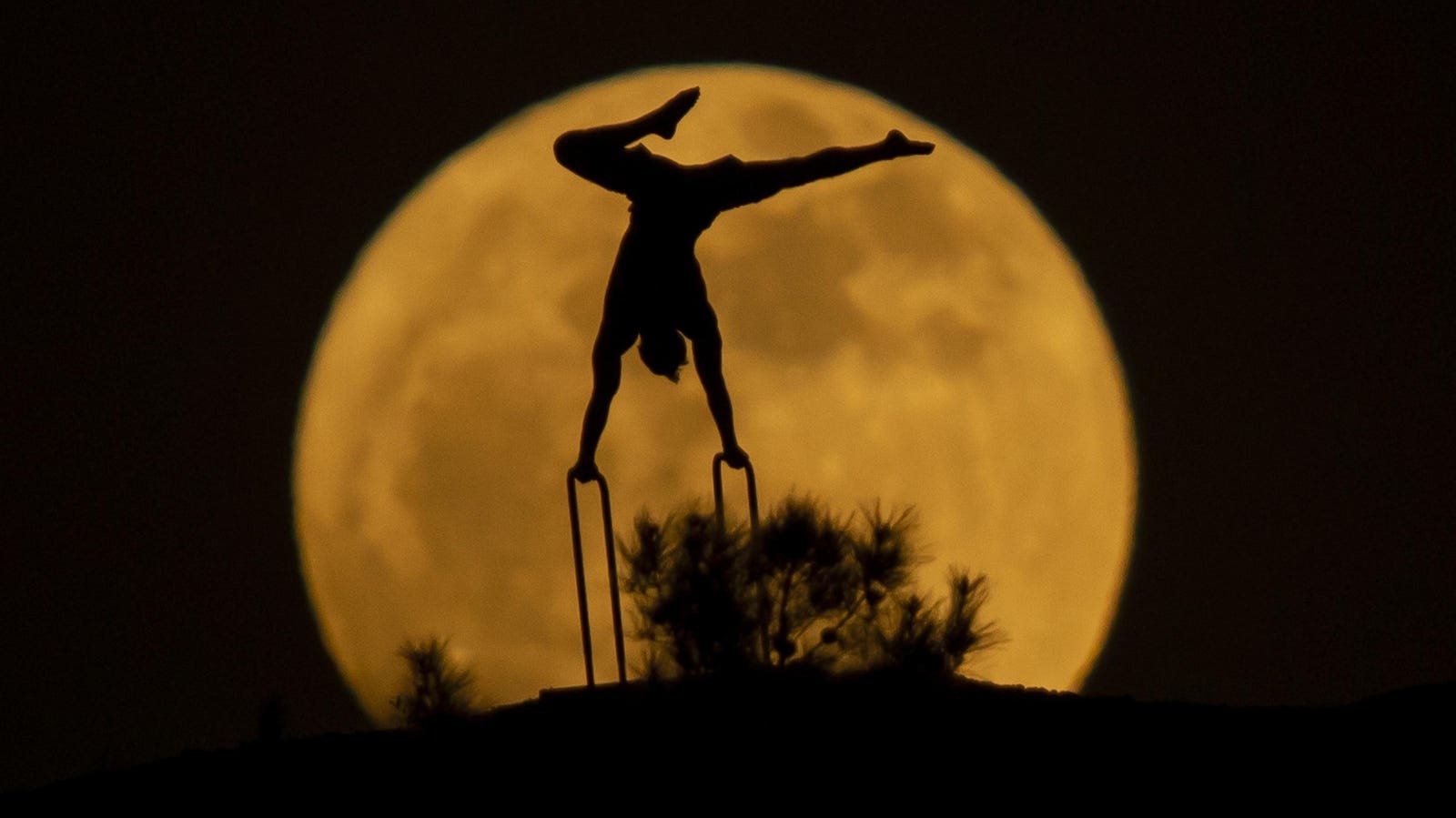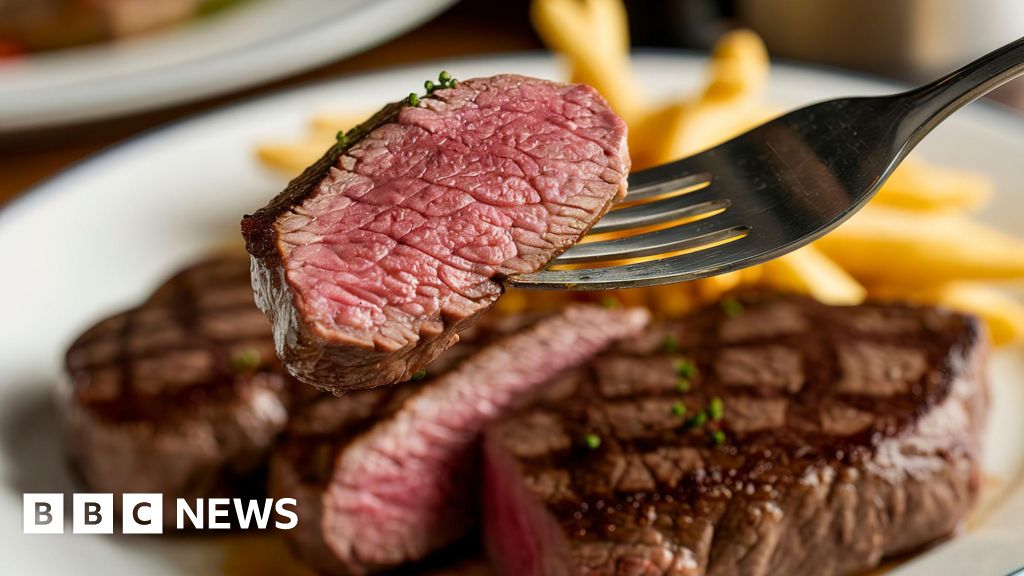Topline
A beautiful full moon — the flower moon — rose into twilight skies on Monday, May 12, casting its bright light across landscapes far and wide. However, it was technically smaller than most full moons — a “micro moon.” Here are all the best images from around the globe.
The full moon is seen behind a silhouette of a man doing gymnastics in Erbil, Iraq on May 12, 2025. … More (Photo by Ahsan Mohammed Ahmed Ahmed/Anadolu via Getty Images)
Key Facts
On Monday, May 12, the full flower moon appeared on the eastern horizon during dusk as seen around the world, having turned officially full at 12:57 p.m. EDT.
It was the second full moon of spring in the Northern Hemisphere and of fall in the Southern Hemisphere. Photographers timed their shots carefully to image it as it appeared beside buildings and mountains while close to the horizon.
May’s flower moon is named after spring flowers in the Northern Hemisphere, though it’s also called the planting moon, hare’s moon and milk moon.
The name milk moon is an old English name. According to NASA, an English monk, the Venerable Bede, wrote in 703 AD that what we now call May was the “Three-Milkings Month” because cows could be milked three times a day.
May’s full moon is the fifth of 12 full moons in 2025, three of which will be “supermoons” (in October, November and December). September’s full moon will be a “blood moon” total lunar eclipse, though it won’t be visible in North America.
The full moon rises beyond artwork atop the Kansas City Convention Center, Monday, May 12, 2025, in … More Kansas City, Mo. (AP Photo/Charlie Riedel)
The Moon In May
Beyond the full flower moon, there are plenty of chances to see our natural satellite in the night sky. After dark on Tuesday, May 13, the waning gibbous moon will pass within a third of a degree of Antares, the brightest star in the constellation Scorpius, “the scorpion.” On Monday, May 26, there will be a new supermoon as it stays out of the night sky but comes closest to Earth for the whole month while lost in the sun’s glare. It could mean higher tides than usual.
Artwork atop the Kansas City Convention Center is silhouetted against the rising full moon Monday, … More May 12, 2025, in Kansas City, Mo. (AP Photo/Charlie Riedel)
When To See The Crescent Moon And A ‘smiley Face’
In the northwest after sunset on Tuesday, May 27, a slender crescent moon will shine just above bright Jupiter, while at the same time, on Thursday, May 29, a slightly larger crescent moon will help create a “smiley face” with bright stars Castor and Pollux — the bright twin stars of Gemini — as the eyes.
The full moon sets behind the St. Isaac’s Cathedral in St. Petersburg, Russia, early Tuesday, May … More 13, 2025. (AP Photo/Dmitri Lovetsky)
The Next Full Moon
The next full moon will occur on Wednesday, June 11. Known as the strawberry moon, it will be the final full moon of spring in the Northern Hemisphere and fall in the Southern Hemisphere, astronomical seasons that will come to an end on Saturday, June 21, when the solstice occurs.
The full moon, also known as the Flower Moon, rises over St Mary’s lighthouse in Whitley Bay on the … More north east coast of England. Picture date: Monday May 12, 2025. (Photo by Owen Humphreys/PA Images via Getty Images)
Trump Administration May Slash Nasa’s Budget
A proposal by the White House earlier this month would reduce NASA’s current budget of $25.4 billion — around 0.3% of federal spending — to $18.8 billion. That would greatly affect NASA’s plans to explore the moon. NASA’s funding peaked at 4% of the federal budget during the Apollo missions to the moon in the late 1960s and early 1970s.
Full moon rises behind Galata Tower in Istanbul, Turkiye on March 12, 2025. (Photo by Isa … More Terli/Anadolu via Getty Images)
Nasa May Curtail Artemis Missions To The Moon
Although the proposals underscored “returning to the moon before China and putting an American on Mars,” they will entail slashing NASA’s Artemis missions to the moon. In April 2026, NASA’s Artemis II mission will see four astronauts launch in its Orion capsule on its Space Launch System rocket and travel beyond the moon. The follow-up in 2027 or 2028, Artemis III, will see two astronauts land on the moon, though future missions are now in jeopardy.
The full moon is pictured from the MAS Monumental stadium in Buenos Aires on May 12, 2025. (Photo by … More Luis ROBAYO / AFP) (Photo by LUIS ROBAYO/AFP via Getty Images)
Further Reading
ForbesCongress Urged To Reject Trump’s ‘Destructive’ NASA PlanBy Jamie Carter
ForbesNASA Urges Public To Look At Night Sky Now For ‘Nova’ LocationBy Jamie Carter









